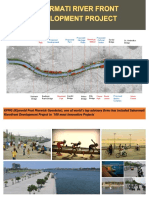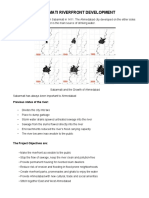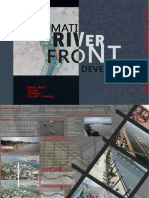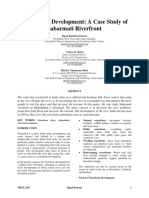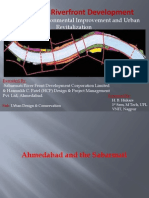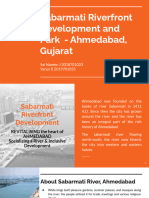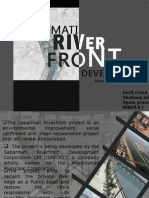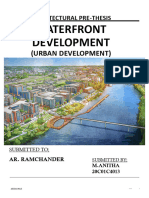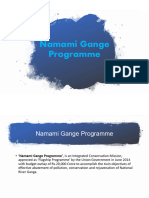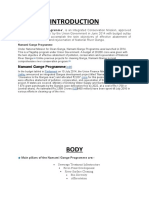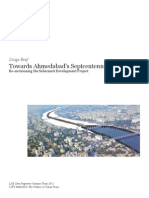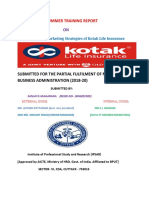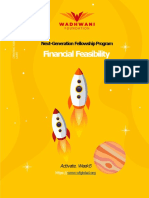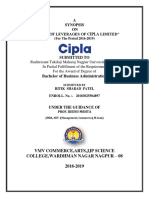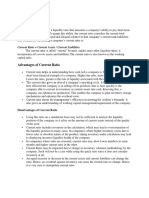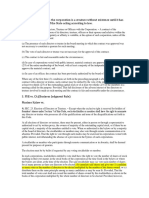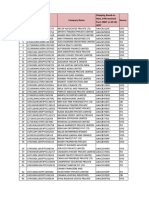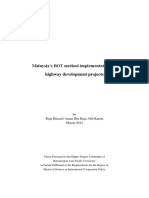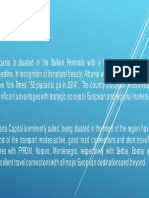Sabarmati
Riverfront....
Socializing a River
& Inclusive Development
By, Sabarmati River Front
Development Corporation
Limited & AMC
�Sabarmati
Riverfront
Sabarmati
Riverfront....
Socializing a River
& Inclusive Development
River Sabarmati, the lifeline of
Ahmedabad, gained global recognition
when Mahatma Gandhi set up his ashram
on its bank in 1917, lived there for more
than a decade and, in 1930 led from its
bank the famous Dandi March that roused
the entire nation. Almost after a century,
it is again in the news, all over the world.
Gujarat Chief Minister Narendra Modis
pet project Sabarmati Riverfront Project
has made waves at international level.
KPMG, one of the worlds top
advisory firms has included Ahmedabads
Sabarmati
Riverfront
Development
Project in the list of 100 Most Innovative
Projects in the field of urban regeneration
(2012) that make cities livable as well
as sustainable. Ahmedabad Municipal
Corporation (AMC) received HUDCO
National Award 2012 for innovative
infrastructure development for the
Riverfront Project.
This project also bagged the
Prime Minister award for the best concept
and design of a public project. In 2006,
the Sabarmati Riverfront Project had also
won the National Safety Council of India,
Safety Award.
Though the project has won
several awards on different fronts, the
most significant USP about this landmark
project has not been highlighted enough.
This project is unique because it truly
socialized a river, a historic river, which
through decades of neglect and decay,
had become a pathetic caricature of a
river. The project dealt with sensitive
issues like slum rehabilitation, relocation
of an age old natural market and a Dhobi
Ghat with lan. This project by its inclusive
nature has benefited the people from the
lowest strata of society. This project has
connected the river and people, again
directly through its ghats.
The
Sabarmati
Riverfront
Development Project was conceived and
is being implemented as a pioneering
multi-purpose project with significant
urban transformation potential. A Special
Purpose Vehicle called the Sabarmati
Riverfront Development Corporation Ltd.
(SRFDCL) was formed for implementation
of the project. The SPV model was being
used to avoid the delays associated with
municipal decision making, introduce
ease in raising resources, and gives
implementation efforts a definitive thrust
and focus.
�Sabarmati
Riverfront
SRFDCL reached out to several
NGOs and citizen groups during the
process of planning and implementation.
SRFDCL retained consultants and
planners wherever necessary for project
implementation. The implementation was
done on a Build, Maintain, Operate and
Transfer basis. Private sector contractors
were selected on fixed time, fixed rate
contracts through transparent and
competitive biddings processes and
supervised by independent Third Parties
appointed by SRFDCL.
The financial cost of the initiative
was estimated to be in the range of
around INR 11520 million or USD 230
million. Around two thirds of this amount
has already been invested. The proceeds
from the sale of land created by the
project is expected to cover the full
cost of the project, including the cost of
interest paid on construction, period loans
and repayment of equity investments.
The sale of portion of reclaimed land
(not more than 14% of reclaimed land,
though allowed to sell 20 per cent) is
envisaged to assist the financial viability
of the project so that the public funds
are not stretched. This clear thinking and
structuring contributed to the perfect
implementation of the project.
In the subsequent pages, we
deal with the human challenges that this
gigantic project dealt with successfully.
�utments
Before
As a place for the poor to build their hutments
Now
Rehabilitation of
Slum Dwellers
Gujari Bazaar Sunday Market
There were nearly 12000 hutments
on both banks of the river occupying nearly
20 per cent of the critical project area. A
committee was formed under an ex-High
Court Judge for finalization of beneficiaries
and a Comprehensive Settlement was arrived
at under the supervision of the honble
Gujarat High Court. More than 10000
families have already been allotted houses
for resettlement. 9078 odd families have
already been shifted and the remaining is
under the process. Of the total allotments,
6 were Christian, 3874 were Muslims and
5198 were Hindus. Each house is of 26.77 sq
m carpet area. They were provided with a
playing area for kids along with recreation
facility. Normally, such relocations of slums
usually happen in far-off outskirt areas of
the city, whereas in this case the resettlement
areas were very much in the prime locations
in the city. Current market value of these
houses is in the range of INR 10 to 25 Lakhs.
Since a river is treated as the mother in
India, it was decided to empower the women
in this rehabilitation project by allocating the
house in the name of the woman member or
in joint name.
Gurjari Bazaar is an age old Sunday Market,
where women traders comprise close to 40 per cent
and half of these describe themselves as Dalits. The
bazaar provides livelihood for an estimated 200,000
lower-income residents, through a complex regional
chain of artisan entrepreneurs, home workers,
mechanics, technicians and small traders. It used to
operate near Ellis Bridge on the Riverfront without any
infrastructure and used to spill out on the adjoining
approach road. It was unhygienic and subjected to
risk of flooding during monsoons. Now, it has become
the first well developed informal market in India. A
MoU was signed between the Ahmedshah Gurjari
Association and Sabarmati riverfront Development
Corporation. Out of 1200 members of association,
726 members (60.5%) are Hindus and 474 members
(39.5%) are Muslims.
Before
Today it is spread over 70,000 sq.mt and 1600
vendors can do their business on 778 pucca platforms
and 783 laris. Adequate parking space is provided
for 280 two wheelers, 425 four wheelers (1700 two
wheelers) and 8 nos of heavy vehicles. More than
200 street lights have been provided in this Market
and 800 trees have been planted. Also other basic
facilities like toilets, food-court, drinking water, and
seating area have been provided. With this unique
rehabilitation exercise, the litigation and the stay
order from the High Court could also be vacated to
pave way for the new initiative.
Now
�Dhobi Ghat
There were nearly 172
Dhobis using both the banks of
the river for washing activities.
They were relocated into the
Dhobi ghat (laundry campus),
which is constructed on the
eastern bank of the River near
Vasna Barrage.
Before
Before
There are 7 blocks in the
Modern Dhobi Ghat and each
block is having 24 units i.e. 168
units. Well developed water
supply and drainage system has
been provided with water meter
for inlet watering. Washer men
can dry washed cloths on the
top floor of the area provided to
him. Facility has been provided
to use pulley to take the washed
cloths to top floor.
Event Area
A
mega
city
like
Ahmedabad requires a proper
event management ground
equipped with modern facilities
for hosting mega events. Hence
an area of 60,000 sq mt, spread
between Sardar Bridge and Ellis
Bridge on the West Bank has
been designated for hosting
such events like the Kite festival,
the Marathon, the Cyclothon,
and Garib Kalyan Mela( for the
urban poor) are organized.
Earlier the dry river bed
was used to host events like
circus and cricket etc. But, now
the
redeveloped
riverfront
provides unique opportunities
to host mega events.
This modern Dhobi Ghat
spread over approx. 9400 sq.mt
area has an utility area of about
6000 Sq.mt. Internal RCC road,
adequate lighting and parking
facility are provided along with
compound wall and providing
security to washmens stuff.
Now
8
Now
9
�Before
Urban Forestry
Sewage System
This unique afforestation
project is spread over 1 lakh
sq mt, is situated between
Vasna Barrage and Ambedkar
Bridge. Natural forestry is being
developed with different plant
species from Gujarat, including
certain very rare species.
An interceptor sewer
system was constructed on
both the banks of the river to
intercept the sewer running
into the river and divert it to the
treatment plants.
This garden comes with
a mediation area as well and
provides the citizens an escape
into vast greenery in the midst
of a sprawling metropolis.
The sewage from 36
drainage points used to fall
directly into the river earlier,
making
the
water
dirty,
mosquito ridden and creating
an unhealthy environment.
All sewage now goes to
pumping stations, leading to
transformation in river quality,
and drastic improvement in the
environment around the river.
Before
A few drains brought sewage into river
Now
10
Now
11
�Connecting River
to Community
Promenade
The diaphragm walls in the bed
of the river and the retaining
walls along both banks have
created a channel for the river,
have stopped erosion of the
river banks, protect the city
from flooding, and allow some
land to be reclaimed for the
city.
Sabarmati river plays an
important role in amongst all religious
groups in Ahmedabad. But gradually
a disconnect developed between the
river and the citizens of Ahmedabad.
The river front development initiative
removed this disconnect and connected
both by constructing 36 Ghats (Steps
having access to the river).
A key feature of
this project is a two-level,
continuous promenade on
both sides of the river. It is
built just above the water level
to serve only pedestrians and
cyclists and to provide access
to the water.
For last 122 years, it has been
a tradition that the Mahant of the
Jagannath temple, along with the
congregation carrying Kalash (Pot) on
elephants approaches the Sabarmati
river and after rituals performed by the
pundits, the water of Sabarmati River
is piously carried back to the temple
to worship Lord Jagannath, before the
Rathyatra starts.
The Riverfront has witnessed
huge religious gathering of Jains,
wherein large number of Jains
perform group Parna (Releasing fast
though a ritual). Religious procession
of Tajiya processions of the Muslims
during Muharram and the structure is
submerged in the river through its stairs
and ghats (Steps).
Now
12
Before
Before
What it means is that
there will be no more private
ownership of any part of
the river bank. The whole
stretch of river banks is open
to every citizen. This is the
true socializing effect of the
riverfront project, which does
not allow private ownership to
the river at all.
Now
13
�Public Gardens/
Flower Garden
27 per cent of project land is
being developed for parks and garden
space for cultural facilities. There are 3
gardens. One garden of 60000 Sq mt,
between Subhash Bridge and Dadhichi
Bridge on east bank and another
Garden of 25000 sq mt at Usmanpura
between Gandhi Bridge and Nehru
Bridge on west bank have already
been open to public.
Before
There will be a flower garden
near the event area spread over 40,000
sq mt. It will be on west bank of the
river.
Now
14
15
�Water Recreation
The project provides for
various water sports facilities
all along the river course on
both banks. Boating facility is
available at various locations
on both banks of the river.
Zip Line, Amphibian Bus and
Sabarmati Darshan, through
ferry and adventure water
sports activities are planned
for near future.
Before
Now
A giant ferry wheel
project, like the famous London
Eye project is also under active
consideration in the riverfront
area.
16
17
�Glimpse
18
Sabarmati Riverfront
Development
19
�20
21
�
The examples clearly illustrate how the river has added
vibrancy to the urban landscape of Ahmadabad with its open
spaces, walkways, well-designed gardens along with activities
which contribute to economic growth. Several other benefits of this
project like recharging of ground water owing to the continuous
presence of water in the river and decongestion of the major north
south road (Ashram road) by providing additional linkages road
to the parallel roads running along the river front are available to
the citizens.
The Sabarmati riverfront project is truly multi-dimensional.
But the inclusive development model that the project attempted
to achieve has been truly unique. Never before has an urban
infrastructure mega project, by a unique inclusive development
model, covered all sections of the city and created world class
facilities for the entire city to enjoy.
22
23
�Lets have a walk at Riverfront...............
Sabarmati River Front
Development Corporation Limited
www.sabarmatiriverfront.com
24
Ahmedabad Municipal Corporation
www.egovamc.com



